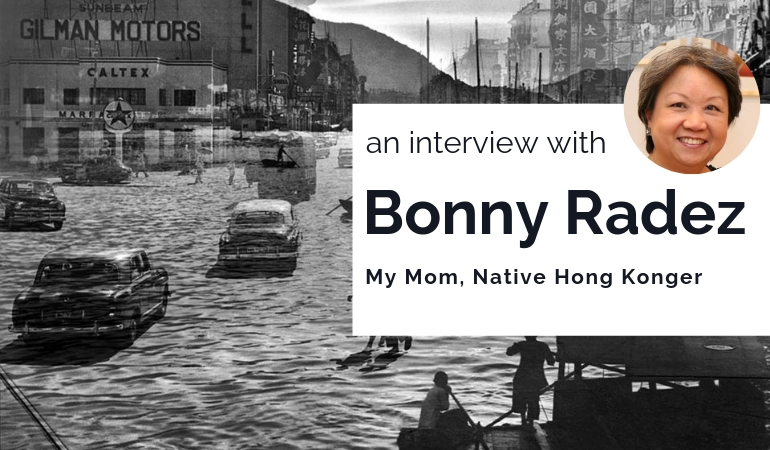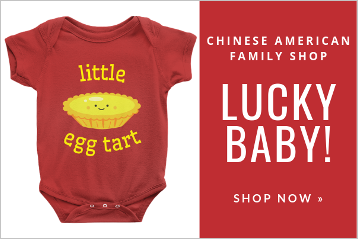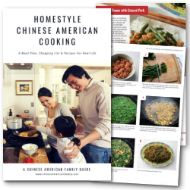This article is part of our Spotlight on Chinese American Leaders. Sign up for our newsletter to receive family-friendly activity, recipe and craft ideas throughout the year!
One of the best parts of Chinese New Year, and any holiday season, is the opportunity to share family stories. It’s fun to tie together the threads of traditions that span generations, learn about relatives we may have never met and hear about the dramas that have shaped our family experiences.
On a recent sunny morning, I had the opportunity to sit down with my mother, Bonny Radez, to hear about her childhood Chinese New Year memories from growing up in the Mongkok neighborhood of Hong Kong during the 1950s. As the parent of a young child myself, I really enjoyed seeing the holiday through my mother’s eyes when she was at a similar age as my son (and her grandson) is now.
Though much has changed since my mother’s childhood years ago and an ocean away, it makes me smile to think about what remains constant. When we asked my son at dinner what he enjoys about Chinese New Year the most, he immediately mentioned the red envelopes he receives and the special foods we eat together, echoing the first things my mother recalled from her own memories. There’s comfort in that consistency.
As you prepare for Chinese New Year, I’d encourage you to make space for your own family conversations. Explore the traditions that go beyond what’s considered “classic” and make your own celebration different and unique. For instance, this year was the first I had ever heard of the casino night my mother’s parents hosted annually in their home.
My mom and I talked for almost an hour about her childhood Chinese New Year memories. She shared details about daily life in 1950s Hong Kong, what she did with her red envelope money and her favorite holiday foods. These are edited excerpts from our conversation.
Take me back to your childhood in Hong Kong during the 1950s. What was your typical day like during your elementary school years?
Well, there were no computer games and all that. I think black and white TV was just coming in. At that time, our family had a cook and I used to go to school in the Uber of the day, these private cars you hired by the month. They would come to pick up children and just jam loads and loads of kids into one sedan.
Breakfast had a lot of variety. Not only congee, but sometimes even fried pork cutlets with toast, which is a very strange thing to have. I didn’t drink milk, so had orange juice or something like that, but even then more likely a whole orange instead of squeezed juice. At that time, my school uniform was culottes, which was crazy because you couldn’t easily take them off to use the bathroom!
Everyone talks about class size these days, but we would have 45 kids in one class. There were no teacher’s helpers or anything like that. We’d have one class mistress responsible for all of us, then each subject would have a specific teacher. We’d have 10 minutes of play time between classes and 45 minutes for lunch, then school lasted until 3 o’clock in the afternoon.
For lunch, kids could bring their own or buy it from school. The kitchen would give you vegetables, meat and fish on a single plate, so even school lunch was a balanced diet. Rice was cooked in a big pot and you got as much as you wanted. After lunch, a man came on a bicycle with all kinds of snacks like ice cream, pickled olives and little snack-sized tofu that we could buy for dessert.
After school, I’d come home in the same car and our family’s cook would have a snack for me. Or later in the afternoon, I’d run down to the local bakery for daan taat. Afternoon and evening was all homework time, even from a very young age.
What changes did you notice in your neighborhood during the weeks leading up to Chinese New Year?
You’d see all the decorations and red stuff being sold. The department stores had decorations that were more like Christmas displays are today, whereas the little mom and pop stores were just red all over! In those days, I remember Christmas being very close to Chinese New Year because of the way the calendar fell. As a result, it just felt like we had a very long winter holiday.
The New Year’s Eve flower market was also a big part of the celebration. It was a popular event that drew big crowds. People bought small kumquat bushes, cut flowers, pussy willow branches and big flowering plum trees. Businesses would spend thousands of dollars on a plum tree with an abundance of buds promising beautiful blossoms for a good year.
What specific traditions do you remember from your family’s preparations for Chinese New Year?
The cleaning, of course, but the cleaning didn’t actually start until the week before. You didn’t do a monthlong cleaning, it was about a week or so. The thing I remember most is filling the red envelopes with my mother. My mother would give a red envelope to every kid we ran into, even the kids of the friends you didn’t know well. And not just one, a pair, one from the wife and one from the husband. Nowadays, people have simplified it to one, but in the old days it was two. There would be hundreds of red envelopes. My mother would have different ones — maybe $1 for general friends, $5 for better friends and $10 for the kids of relatives. You would kind of rate your closeness by the amount of money you put in the envelope.
I’d receive hundreds of dollars of red envelopes each year. We used to have these piggy banks the shape of the HSBC bank building. There was a wire through it and a seal on it. You couldn’t get the money out. You’d put your money in and each month take it to the teller, who would open the seal and put the money in your account. I spent the money on Christmas presents and birthday gifts for my parents and relatives. So all the money saved up was for presents for all these other occasions.
What was the family’s New Year’s Eve meal like?
My mother had no brothers or sisters in Hong Kong and my father had only one brother there, with another in Singapore who would often come. As a result, we pretty much made it a tradition that the New Year’s Eve dinner was at our house and then New Year’s Day would be at my uncle’s house. My mother’s cook would make up all the food before the New Year started, so we would have the big dinner on New Year’s Eve and then the jai vegetarian dish, the dumplings, turnip cake and everything else would be saved to eat until the New Year holiday was over and the Kitchen God returned. The other thing we always had was a pair of sugar cane stalks that stood at the corner in the hallway until the holiday was over. Then we’d all sit around the table in a circle, cut it up and eat it for the sweetness.
What foods were typically served on New Year’s Eve?
Fish, of course, roast pork, a dish with dried oysters and noodles for long life. Every dish is picked for the sound it implies. The dried oyster dish is ho si, which sounds like “good things.” Seaweed is fat choy, which sounds like “come into wealth.” The Chinese eat chicken as a sign of prosperity, as well. Though common, people like to say that chicken means your family is doing OK. It’s like here in the United States, the saying about “a chicken in every pot.” We would always have green vegetables like gai lan, because green is healthy, prosperous and everything good. For dessert, we’d have djeen dui, which can be used for display as well. The Buddhist families would have a pile of djeen dui sitting in front of the House God. Things like dumplings and turnip cake were for the days after New Year’s Eve. You would go visit people and get that family’s specialty.
As a child, what was the part of the holiday you’d look forward to the most?
Well, of course the lucky money and the food. A lot of the food you wouldn’t see the rest of the year. Here’s another one. We didn’t eat potato chips, which didn’t come to Hong Kong until later and first only in the movie theaters. We had shrimp chips, which were served with fried chicken, but not in a bag. At New Year’s time, they had taro chips, cut small in diamond shapes and mixed with crunchy salted peanuts and sweet potato chips. I remember one year I ate so much of it, while drinking 7-UP, that I got sick afterwards. We never had that kind of thing otherwise.
I also looked forward to one gathering my parents had on the second day after New Year’s Day. If you look at the calendar, it’s a bad luck day when people are not supposed to go out visiting other people. But my family decided to take that day for all my father’s pharmacy colleagues, the apprentices over the years who helped him put together capsules and mix cough syrups. These people would show up to gather at our house for a big casino night, a whole day really. We’d have 4 or 5 different tables of mah jong, a big table of black jack, all kinds of gambling things. They’d stay all day late into the night, some would even sleep on the sofa. The place was just jammed with people.
In the evening, there’d be enough food for 30 people. We’d put out these portable tables, each for 10-12 people. There would be two in the living room and one in the dining room, then the kids would be around card tables, just everywhere. People all over the house.
What was the neighborhood like during the rest of the Chinese New Year holiday?
Once in a while you’d hear firecrackers. Normally, you wouldn’t see lion dancers all over the place, only at a new business wanting to bring attention to themselves. They might hire a kung fu club, because those groups had all the athletic people who could do the lion dance. We’d go out visiting, some friends we might only see at this time of year. My mother had high school classmates that she saw once a year over twenty or thirty years! Transportation wasn’t good from where we lived, so to visit a friend in North Point from Mongkok could take an hour or more and three different types of transportation. It could take forever!
Did your parents put much emphasis on sharing traditions and family history with you during Chinese New Year?
Not consciously and, in fact, I feel sorry that I didn’t get more from my mother like you’re trying to get from me. All I learned, they didn’t specifically tell me over the holiday. My father was from Vancouver and he did not know many traditions, only what his parents passed along to him. My mother’s mother lived with us, so there would be some conversation, but nothing explicit. Everything was just by osmosis as people came and went, with maybe a little explanation. She never sat down with me to say, “OK, you ought to know this,” before going through the whole thing.
###
Your turn! What family stories do you enjoy exploring at holiday times like Chinese New Year? What reflections do you draw from my mom’s memories?
HT: Photo by Business Insider.





Leave a Reply